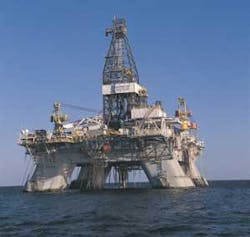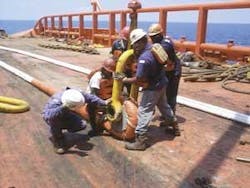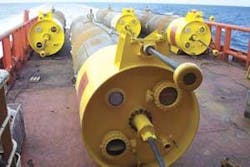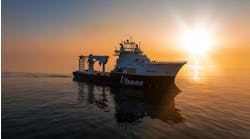Judy Maksoud
International Editor
Success after success of a new polyester mooring system is changing the face of deepwater mooring. The latest evidence of the system's capability is the deepwater mooring record set by Transocean's semisubmersible Deepwater Nautilus in 8,009-ft water depth. The Nautilus set this record on March 6 on Shell's Great White prospect in the Alaminos Canyon section of the Gulf of Mexico.
"Putting any rig in water depth greater than 5,000 ft is significant," said Billy Bergeron, senior mooring analyst for Delmar US, the company that worked with Shell to design the polyester mooring system. "Using the polyester mooring system to do so is revolutionary."
From the past to the future
One of the critical elements of the mooring system is the suction anchor. As is often the case, this component of the new system is a reapplication of existing technology. "The suction pile was invented by Royal Dutch Shell a little over 20 years ago," explained Bill von Eberstein, senior drilling superintendent at Shell, "but the piles were used primarily for permanent moorings." Six or seven years ago, von Eberstein began searching for ways to move existing mobile offshore drilling units into deeper waters without incurring great cost for upgrades. That is when the idea of using suction piles surfaced. Armed with this idea, Shell contracted engineering companies to help design the test piles, then spent $1.5 million to prove the system.
The Deepwater Nautilus on location in the Gulf of Mexico.
The original system was an all-steel wire semi-taut system that was much stiffer than catenary systems.
DP vs. mooring
When Shell began investing money to develop a new mooring concept, the primary objectives were to establish superior station-keeping capabilities in ultra deepwater, reduce operation costs, and enhance the safety and environmental impact of critical operations. The search began with the premise that there is no reason to use a dynamically positioned rig if water depth doesn't require it or if seabed conditions do not necessitate using dynamic positioning (DP).
"Mooring is much better than DP in my opinion," said von Eberstein. Station-keeping is more precise, he said, because it eliminates the possibility of drive-off or drift-off, and difficult follow-up work is not an issue.
Delmar employees making up a connection of synthetic rope.
Though today's DP systems are reliable, "they cannot come close to maintaining the same station-keeping as taut-leg mooring," he said. Even in storm cases in 8,000-ft water depth, Shell has measured offsets of no more than 30 ft using its taut-leg mooring system.
Another vital consideration is planning. Using the pre-set mooring system, Shell moves the operation of setting up the mooring off the critical path. By pre-setting the piles, Shell can quickly and efficiently move a semi from one location to another and begin working almost immediately.
The pre-set mooring allows a rig to hook up and begin drilling much more quickly, said Bergeron. The drive pipe is lowered and ready to contact the seafloor within five hours of arriving on location, Bergeron explained. And handling is actually better than with a wire rope system. When running the BOP, the polyester rope offers more immediate and precise movement, he said.
Putting the system to work
Transocean's Marianas was the proving ground for the first suction anchor system. With this system, the Marianas repeatedly broke world deepwater mooring records in the Gulf of Mexico. The first generation of the system was successful. The improved system, which incorporates polyester rope, is a true taut-leg system, whereas its predecessor is a semi-taut leg system.
Suction piles on the back deck of an anchor handing vessel.
The Nautilus set its world records with a pre-set mooring system that includes eight suction piles with polyester mooring lines, deployed in advance by an anchor-handling vessel. While the Nautilus was drilling its record-depth well, the rig reportedly saw no lateral excursion greater than 15 m.
The future of the system looks promising. Developers agree that it has not yet seen its greatest moment. In fact, testing has indicated that in most cases, out to 9,500 ft of water, the system can pass a 10-year storm case, von Eberstein said. When that limitation is put to the test, the current record of 8,009 ft water depth is destined to be broken.
Setting and retrieving the anchors
Delmar describes the suction anchor system as the most advanced preset mooring system for ultra deepwater. Eight anchors make up a set. The system uses a cylindrical suction caisson as the anchor. The anchor is set using an ROV to pump water out of the top of the caisson until it is fully penetrated into the seabed. The process is reversed to recover the anchor.
The suction anchor mooring system can hold at higher uplift angles, which reduces the circumference of the mooring pattern and reduces the watch circle maintained by the rig. The system allows a rig to significantly extend its water depth capability. The system also provides the ability to target an exact location, soil holding properties, and alignment to the rig, allowing confidence in its ultimate holding capacity.
Time line of GoM mooring records set using suction anchors.
The suction anchor system is installed before the rig moves on location. The anchor is lowered overboard and pumped into the seabed. Then, the mooring line is attached and suspended with a submersible buoy.
Submersible buoys or synthetic line in the mooring system reduce the weight of the mooring leg on the rig. Buoyancy modules are used for three primary reasons, one of which is to reduce weight. The buoys also reduce the stiffness of the system, and they can be used to prevent the polyester rope from coming in contact with the seafloor.
The suction anchor system used on the Nautilus incorporates Delmar's patented subsea connector, which allows the anchor to be deployed with a single line and for the mooring line to be connected or disconnected at any time by ROV. The connector adds flexibility to the system and reduces installation and recovery costs.
Once the rig is on location, it is connected to the mooring legs by one or two anchor-handling vessels, a task that typically takes three to four hours per leg.
When it is time to remove the system, recovery is simple. The suction anchor is pumped out of the seabed and recovered over the stern of the anchor-handling vessel.
Adding the advantages of polyester rope to Shell's pre-set mooring system brings tremendous value to the system and further extends depth capability.
"Polyester can take a rig beyond its designed-in capabilities," said Bergeron. This technology will allow even rigs with depth limitations of 2,000-3,000 ft to drill in 6,000 ft water depth, he said.
Doing the impossible
Incorporating polyester rope in a mooring system is one thing. Using it in conjunction with wire rope is another. Six-strand wire rope is traditionally expected to rotate. Common belief has been that a rotating wire rope would transfer rotation to the polyester rope, causing it to self-destruct. Despite this assumption, the Shell/Delmar installation uses controlled proportions of polyester rope and six-strand steel wire rope within a single anchoring leg. Carefully calculated proportions of polyester attached to six-strand wire rope successfully held the Nautilus on location for the duration of its record-depth-setting well. In effect, the mooring record proves the system. Undeniably, the system gives outstanding performance.
Improving anchor handling
With the successful application of the new mooring system, Shell has targeted the anchor-handling vessel as the next element of the system to be improved. The primary reason for building a new vessel is the polyester rope's large diameter. Wire rope is generally 3 3/4 in. in diameter. The polyester rope has a diameter of 6 7/8 in. Edison Chouest Offshore has designed the new anchor-handling vessel to safely and efficiently handle the synthetic system.
Shell and Delmar helped design the work deck areas to best handle pre-installed mooring systems. Special handling tools designed for the vessel will prevent damage to the rope, said Bergeron.
Shell entered into a contract with Edison Chouest for what von Eberstein calls "the biggest, most capable anchor-handling vessel in the world." The new vessel, to be christened Laney Chouest, will be 347 ft x 72 ft, with 36,000-hp engines and a 660-ton four-drum winch. The Laney Chouest is scheduled to go through commissioning in early November.
Polyester plus
The next step in system improvement will be reducing the diameter of the polyester rope. At present, however, it looks as if the next step might not be taken any time soon. The reason for the delay is the scarcity of high-molecular polyethylene, called Dyneema, which is the most suitable small-diameter high-strength material. Serious evaluation and testing have already been done, and the polyethylene appears to be a viable option.
The problem is that there has been a tremendous increase in demand over the past year for ballistic material, and it is simply not available in the necessary quantities for use in the drilling industry. Until this material is available at a reasonable price, it will not be an option for reducing the diameter of synthetic rope. According to von Eberstien, Dyneema rope has been used successfully in shallow water off Indonesia, but it will be some time before cost, quality assurance, and technical issues are fully resolved. Only then can the material be applicable in the Gulf of Mexico.







